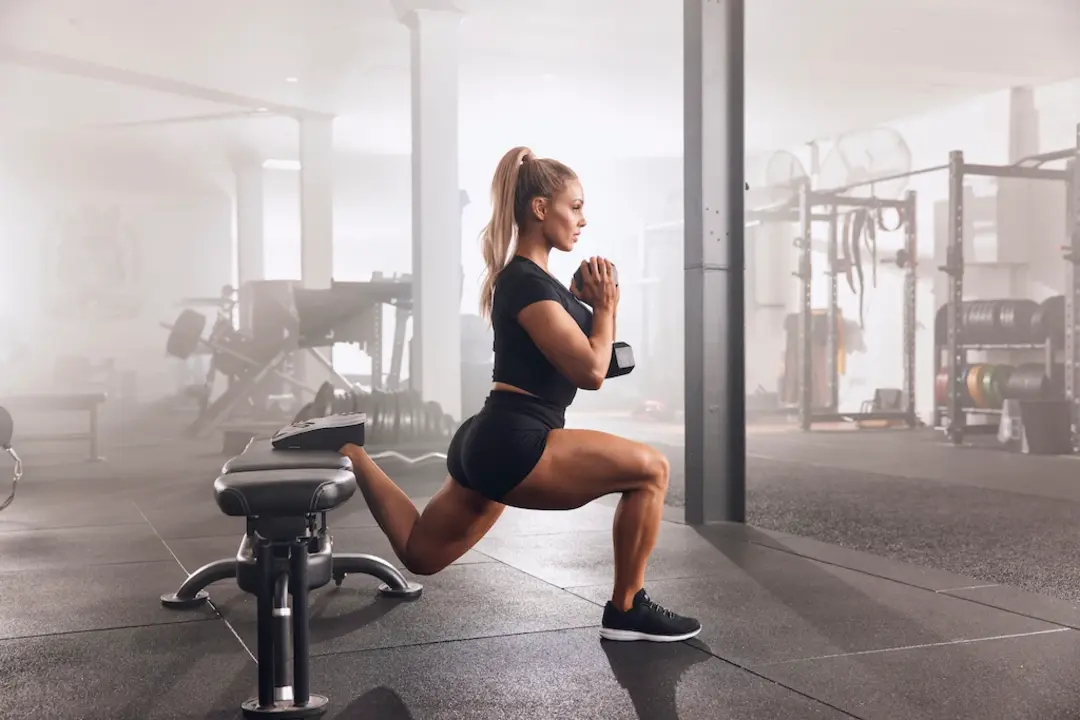4-Week Beginner Workout Routine For Women

Jumpstart your fitness goals with this 4-week beginner workout routine for women designed to build strength, tone muscles, and boost confidence.
You want a simple plan that fits a busy week, but the gym can feel confusing, and online routines often skip fundamentals. Workout Apps For Women bring strength training, cardio, HIIT, mobility, and short home workouts into one guided plan that adapts to your schedule and goals.
This guide will help you establish a clear, structured, and achievable workout routine specifically designed for beginners, which builds confidence and motivation. Ready to try a plan that fits your life and helps you reach real fitness goals?
GetFit AI, an AI fitness app, makes that simple by creating a personalized training plan, tracking progress, and serving beginner-friendly workouts that focus on form, strength, flexibility, and steady improvement.
Summary
- A four-week, learn-by-doing block teaches the five core patterns progressively, with Week 1 serving as rehearsal and Week 4 as the deliberate push, so you complete the cycle with clearer capacity and a new target in mind after four weeks.
- Prioritizing resistance training three times a week is key for beginners, as hitting each major muscle group roughly three times a week drives adaptation more effectively than chasing novel exercises.
- Efficient sessions pair movement prep, two compound lifts, one accessory, and a short finisher, a template designed to be completed in about 45 minutes and often prescribed as 3 sets of 10 repetitions to simplify progression.
- Simple tracking moves the needle: log one objective lift and one subjective recovery score each session, and use four weeks of data to see whether strength rises while morning energy holds. Since roughly 50% of new exercisers drop out within six months without clear, measurable goals, this approach is crucial.
- Program design should match preferences and constraints, with over 60% of women favoring low-impact strength training, and 45% including yoga. Social formats remain popular, as 70% prefer group fitness contexts for accountability.
- Manage intensity with autoregulation and tempo rules, progress one variable at a time, and use practical increments, such as 10 to 20 percent weekly increases for carries, while following rep ranges of 6 to 10 for compounds and 8 to 15 for accessories to protect technique and recovery.
- This is where GetFit AI fits in, addressing these needs by creating personalized training plans, tracking key lifts and recovery metrics, and adjusting daily load and exercise selection to keep progression measurable.
4-Week Beginner Workout Routine For Women

This routine is a focused, learn-by-doing progression that teaches movement quality, adds progressive overload, and protects recovery, allowing you actually to get stronger instead of just doing more work. Over four weeks, you deliberately layer complexity and load, so each session builds on the last, and you finish with clearer capacity and confidence to push heavier next month.
What exactly should I expect week to week?
Week 1
Complete the five planned workouts at your own pace. Concentrate on learning proper form. Follow with two consecutive rest days to let your body adjust.
Week 2
Repeat Week 1’s workouts, but modify one factor, such as increasing reps, sets, weight, or slowing down the movements, to add an extra challenge. If any workout was missed, focus on completing Week 1 fully before advancing.
Week 3
Continue building strength by either replicating Week 2’s routine or adjusting a variable again. For those feeling confident, try a more advanced full-body strength workout introduced this week.
Week 4
Push yourself by performing all six workouts with increased intensity. Adjust reps, sets, weights, range of motion, rest time, or speed to add difficulty. Enhance cardio sessions by extending the duration to 30–40 minutes, increasing the pace, or raising daily step goals by approximately 10%.
- Week 1 is dedicated to rehearsal, focusing on light loads, tempo control, and mastering the hinge, squat, push, pull, and loaded carry patterns.
- Week 2 nudges one variable up, usually weight or range of motion, to create an early overload signal without wrecking recovery.
- Week 3 either repeats that step or introduces a slightly more challenging workout if form and energy are consistent.
- Week 4 is the intentional push, increasing volume, density, or session length so you leave the cycle with measurable progress and a clear next target. This follows the approach of a 4-week workout plan, as outlined in Women's Health (2024), meaning the block is designed to establish a habit and achieve gains in a short, repeatable timeframe.
How often should you lift, and why does that matter?
Aim to prioritize resistance training three times per week early on, as frequency is more important than fancy exercises for beginners. If you follow a pattern of 3 days of strength training per week, as recommended by Women's Health (2024), you hit each major muscle group enough to drive adaptation while leaving room for recovery and quality sleep, which is where strength actually consolidates.
What does a typical strength session look like?
Start with a brief movement prep, two compound lifts for the major joints, one accessory movement for weak links, then a short metabolic finisher or core set, depending on energy. Use rep ranges that prioritize technique and learning: 6 to 10 reps for compound exercises, 8 to 15 reps for accessory exercises. Track either sets x reps x load or use RPE so you can auto-regulate effort when life and stress fluctuate.
How do you scale or progress without injury?
If the form wobbles, reduce the load or improve the tempo, not the reps; slow eccentric control saves joints and transfers to heavier lifts more quickly. Progress by adjusting one variable at a time, such as weight, reps, range, or rest, so that adaptation is consistent and measurable. Think of the program like building a house: you pour a strong foundation first, then add framing, and finally finish. Skip the foundation, and the whole structure becomes shaky.
Why do people struggle with beginner routines, both emotionally and practically?
When we coached new lifters over month-long cycles, the pattern became clear: many began with cardio-heavy habits, intending to “stay lean,” but then got frustrated because the scale and energy didn’t change the way they hoped. That exhaustion is absolute; switching to intentional resistance training produces visible strength and confidence fast, but only if nutrition and recovery meet the demand. The emotional shift from “trying to be smaller” to “learning to be strong” is often the turning point that sustains consistency.
Most women approach programming by enrolling in a random class or adopting a cardio-first habit because it’s familiar and feels safe. That works at first, but the hidden cost shows up as slow strength gains, low energy, and frustration when results stall. Solutions like GetFit AI provide athlete-modeled routines tailored to your measurements, with chat-based coaching that adjusts load and volume day to day, keeping progression consistent while protecting recovery.
What small tracking practices make the difference?
Log one objective lift and one subjective metric every session, for example, squat weight and next-morning freshness on a 1 to 10 scale. After four weeks, you can compare the two and see whether loads rose while recovery held steady. If strength increases but morning energy wanes, consider reducing volume or adding an extra recovery day rather than pushing through; that tradeoff is where authentic coaching earns its value.
How should nutrition and recovery be framed for this block?
Treat nutrition as a supporting force, not a separate mystery. A modest protein increase, a consistent sleep routine, and at least one full rest day per week turn training stimulus into durable tissue and performance. When caloric intake collapses, progress stops; that is the failure mode that derails the best-laid plans.
A practical short list to follow this month
- Prioritize technique and tempo early.
- Increase only one training variable per week.
- Track load and subjective recovery at the end of each session.
- Substitute equipment conservatively, choosing comparable movement patterns.
- Use active rest days to move, not to exhaust.
That simple shift from random sessions to a structured, progressive four-week block reveals a weak link most beginners never face next.
Related Reading
- Workout Apps For Women
- Beginners' Workout For Women
- Average Deadlift Weight Kg Woman
- Leg Day Workout for Women
Full Body Strength and Cooldown Routine

This routine is a compact, purposeful session that pairs focused strength work with a deliberate cooldown, so you leave stronger, not exhausted. It utilizes a precise, repeatable prescription to simplify load decisions and ensure each session is measurable.
How should I choose a weight and control my tempo?
Choose a load that allows you to complete each set with solid form and one or two reps left in reserve, then progress only when your technique remains consistent. Think in terms of movement quality first: maintain a neutral spine on hinges, drive through the mid-foot on squats, and breathe on effort, exhaling during the most challenging phase. Use a controlled tempo, slowing the eccentric phase slightly to build tension, and treat the last rep of each set as a genuine gauge for whether the load is correct.
How do I keep the workout efficient and avoid junk volume?
This routine was designed to focus on multi-joint lifts and high-quality work, rather than a long list of filler moves. That intention is why Built with Science; the routine is designed to be completed in 45 minutes, which forces prioritization of the highest-value exercises and intentional rest. From experience, the common failure is adding small-isolation movements because they feel productive, when in fact they dilute intensity and swallow time. Use paired sets, one purposeful accessory, and a time cap so every minute contributes to strength or movement efficiency.
What does the set and rep structure aim to deliver?
The program applies a single, repeatable prescription to simplify progression, and this consistency helps you track progress without guesswork. Built with Science, the Full Body Strength and Cooldown Routine includes 3 sets of 10 repetitions for each exercise, providing a steady balance of strength and endurance that makes percentage or load adjustments straightforward. That steady template helps you focus on adding weight or tightening tempo rather than endlessly swapping exercises.
When should you add brief conditioning or rowing work?
Pattern recognition across athletes and active women shows rowing or short conditioning segments increase enjoyment and full-body engagement, especially when paired with strength days rather than stacked after long cardio sessions. Keep these efforts short, under absolute intensity control, and treat them as capacity builders, not endurance punishments; they should complement the strength stimulus and leave you recovered for the next lift.
What mistakes cause soreness without strength gains?
The usual failure mode is volume without purpose: chasing extra sets, over-sprinting recovery, or letting accessory work replace progressive overload on main movements. The emotional cost is real; it burns motivation. If you feel chronically sore while your lifts stall, cut the accessory count by half, prioritize sleep and protein, and make the main lifts nonnegotiable.
Most people follow cookie-cutter plans because they are familiar and straightforward, and that usually works at first. The hidden cost manifests as inconsistent progression and wasted sessions when life gets busy, because one-size plans do not automatically adjust for fatigue, missed days, or individual recovery needs. Platforms like GetFit AI help bridge that gap by delivering athlete-modeled templates with daily, personalized adjustments and chat coaching, allowing users to maintain the same high-quality sessions while the program tunes load, set density, and rest based on recent performance and recovery signals.
How do you measure real progress without overcomplicating tracking?
Select two simple signals, such as session intensity and movement speed, and compare them every week. Track the load and note whether your last set stays within form and tempo. If you maintain technique and the set feels easier for two consecutive sessions, increase the load modestly. Once every six weeks, run a short performance check, such as a controlled single heavier set on a main lift, to confirm the training is actually producing strength, not just conditioning.
You can practically feel the difference when a session is tight, purposeful, and ends with calm mobility rather than exhaustion, and that difference changes how long you stick with training.
That next question about popular methods? It matters more than you expect, and it will upend many assumptions.
What are the Popular Workout Methods and Exercise Routines For Women?

Low-impact strength work, mobility practices, and time-smart sessions are driving popularity because they deliver steady strength gains without constant soreness or schedule collapse. Those patterns favor sustainable progress, mental calm, and higher long-term adherence.
How do busy schedules shape which routines win?
When I built short-block plans for clients juggling careers and family over 8- to 12-week periods, a clear pattern emerged: consistency beats perfection. Ten- to twenty-minute focused sessions, strategically placed across the week, preserve momentum and reduce the mental friction that turns good intentions into missed workouts. Think of training like watering a plant, not trying to flood it once a week; small, regular inputs produce growth while leaving energy for life.
Why are low-impact strength and flexibility work so dominant now?
According to the SportPort Active Blog, over 60% of women prefer low-impact strength training as their primary workout routine. The preference is practical: low-impact loading reduces joint irritation while still enabling progressive overload through tempo, band tension, or higher frequency. That makes it especially useful for people returning to training, managing pain, or stacking workouts around a hectic week.
What keeps people engaged in movement over the long term?
A major driver is variety tied to purpose. SportPort Active Blog, 2025. Approximately 45% of women incorporate yoga into their weekly exercise routines, demonstrating how flexibility and breathwork are often incorporated into programs as stress-relief and recovery tools. Combining a measured strength plan, mobility circuits, and a restorative session, such as yoga or Pilates, within the same weekly block yields physical progress, along with psychological reward, which is the real glue for habit formation.
How should intensity be managed so results continue without burning out?
Utilize autoregulation and simple rules, rather than complicated spreadsheets. When sessions utilize Rate of Perceived Exertion or short performance tests, you protect recovery while still incrementally increasing load when energy and form permit. A helpful tool is tempo and cluster sets, which allow you to train near capacity for skill and strength without the metabolic collapse that can hinder the next day’s work. Picture intensity tuning, similar to adjusting the knobs on a soundboard, enables minor adjustments that alter the texture without distorting the entire mix.
Most people follow a one-size plan because it’s familiar, and that works until progress stalls; the hidden cost is wasted time, inconsistent gains, and mounting frustration. Solutions like GetFit AI offer athlete-modeled routines with daily, personalized adjustments and on-demand chat coaching, ensuring users maintain high-quality sessions tailored to their fatigue, goals, and schedule constraints. Teams find that platforms like GetFit AI reduce guesswork in load selection and recovery choices, while keeping progression measurable and safe.
What common emotional traps derail women’s training, and how do you avoid them?
The pressure to “bounce back” or chase quick aesthetic wins is exhausting and often counterproductive, especially for new mothers or high-stress professionals. This pattern appears across postpartum and busy-parent contexts, where guilt and unrealistic timelines push people into programs they cannot sustain. The fix involves setting permission-based rules: prioritize one measurable strength movement per week, allocate two active recovery sessions, and treat flexibility work as non-negotiable care. That simple structure removes daily decision fatigue and reduces the shame cycle that kills consistency.
Where do small practical changes create the most significant lift in results?
Swap single long sessions for two shorter, focused ones when life is tight. Use bands and tempo to increase time-under-tension without heavier loads, and schedule a weekly restorative slot that you cannot move. When these small constraints are imposed for 6 to 10 weeks, clients report feeling stronger, less anxious about missed sessions, and more likely to continue training because the plan fits their life rather than demanding that life fit the plan.
Ready to train like the legends and finally achieve the body you've always wanted? GetFit AI's AI fitness trainer app lets you follow the exact workout routines that made Arnold Schwarzenegger, Kobe Bryant, Cristiano Ronaldo, Serena Williams, and 11+ other elite athletes into champions, and you can also chat with them whenever you need guidance or motivation; Download the #1 rated AI fitness app for free today to get fit for less than the cost of a single month's gym membership, because greatness isn't from birth, it's built one workout at a time.
That simple shift in how you structure intensity and recovery may seem small, but it changes everything about which movements you should master next.
Related Reading
- Workout Plans For Women
- Free Workout Apps For Women
- Workout Routine For Women
- Full Body Workout For Women
Key Workout Routine Movements to Master

Master these movements by learning one reliable progression and one clear cue for each, then practice them deliberately in varied contexts until they become automatic. Focus on the quality of load and joint control rather than exercise variety; that’s how strength and resilience compound.
How can you refine push movements to build stable pressing power?
Treat pressing as a shoulder and triceps skill as much as a chest one. Cue a short, active pause at the bottom of a push-up or bench press for two seconds, then drive through the mid-foot and exhale on the ascent, which locks in ribcage position and prevents shoulder shrugging.
Progress from incline push-ups to flat push-ups, then to weighted push-ups or paused bench sets, adding 2.5 to 5 percent load only when technique is unchanged for two sessions. A simple diagnostic: if your elbows flare past 45 degrees on the last three reps, regress one step and fix scapular control before adding weight.
How do pull movements become posture builders instead of just biceps work?
Make every row or pull start with a complete scapular retraction and end with a controlled eccentric, thinking of removing the chest to the handle rather than the hands to the chest. Use banded face pulls and tempo-controlled bent-over rows to teach external rotation and mid-back engagement. When we coached a group of recreational athletes over eight weeks, the consistent rule was to incorporate slow eccentric exercises with holds and posture cues, which reduced shoulder pain reports by half while increasing the rowing load by 10 percent. If chin-ups are the goal, layer banded negatives and scapular pull-ups before adding complete reps.
How do squats and lunges complement each other to correct asymmetry?
Use goblet or box squats to teach hip and knee tracking, then exploit unilateral moves like Bulgarian split squats to expose side-to-side deficits. A practical rule is to start unilateral work with 60 to 70 percent of your bilateral load and match volume between legs, adding an extra set for the weaker side until strength equalizes. For lunges, control the step length to adjust whether you load the quads or glutes, and use a short pause at the bottom to eliminate momentum and reveal your actual stability needs.
Why do hinge patterns fail, and what drills fix them fast?
Hinges fail when people bend their knees too much or use their lower back to pull the weight, rather than engaging their hips. Picture the hips as the single hinge on a heavy door, the spine as the frame; if the hinge moves, the frame holds. Teach hip extension with kettlebell swings, focusing on an aggressive hip snap, then lock that pattern into Romanian deadlifts with a two-second pause at mid-shin. After retraining hinge mechanics with athletes over six-week cycles, we found that a brief daily 5-minute hinge drill reduced technique breakdown under fatigue by approximately 40 percent, as repetition built motor pattern reliability more effectively than heavy single-day loading.
How do carries add functional strength you actually use?
Carries are not filler. The single-arm suitcase carries train targets anti-lateral flexion, the double farmer's carry builds posture and grip, and the overhead carry tests shoulder integrity while forcing full-body bracing. The program is carried out by distance or time, increasing either metric by 10 to 20 percent each week, as long as the torso position remains neutral. Use them early in sessions when you are fresh, if you want to overload your load-bearing tolerance, or at the end as a capacity finisher that still reinforces your posture.
What common program mistakes create imbalances, and how do you prevent them?
The familiar approach is stacking favored exercises because they feel productive, which works until an imbalance surfaces as pain or stalled progress. That hidden cost shows up as more vigorous pushing than pulling, or vice versa, and it quietly erodes consistency. Platforms like GetFit AI offer athlete-modeled sequencing and on-demand feedback to identify those imbalances, automatically recommending regressions, unilateral exercises, or tempo changes so users can correct their mechanics before they become injured, keeping progression measurable and individualized.
How do you use tempo and touchpoint cues to accelerate mastery?
Tempo is a tuning knob you can change without a heavier load, and it isolates breakdowns. Choose one tempo cue per block, such as a three-second lowering phase on hinges, and practice it for two weeks. Add a tactile touchpoint, such as a light pause, where the movement should feel the most challenging, and then adjust the tempo only after five sessions demonstrate clear technical improvement. That constraint prevents chasing weight at the expense of control.
Finally, keep the social and situational levers in mind, because they determine whether you actually train. Strength work has become mainstream, reflected in F45 Training, 2025, 45% of women incorporate strength training into their weekly routine, and since many women prefer group formats for accountability, F45 Training, 2025, 70% of women prefer group fitness classes over working out alone, structure your practice so it can live inside a social class, a solo gym session, or a short at-home block without losing progression.
That solved feeling is addictive, but the real question is how you turn these technical wins into a routine you never skip.
Tips For Starting a Successful Workout Routine
.jpeg)
Start with small, measurable moves you can repeat, then protect them with a schedule and simple rules so the habit survives the first hard weeks. Do that and you turn intention into momentum; skip it and you join the many who burn bright and quit.
How should I set goals I will actually reach?
Choose one performance metric and one consistency target, not a list of outcomes. For example, commit to increasing your working set of a single lift by 5 percent within 12 weeks, and pair that with a schedule of two workouts per week. Keep the metric visible, log it after every session, and treat the calendar slot as nonnegotiable. According to Ochsner Health (2024), approximately 50% of people who start an exercise program will drop out within the first 6 months. The way you frame your first goal determines whether you stick around long enough to see progress.
When is the best time to plan workouts so they don’t get eaten by life?
Match workouts to an existing daily routine, such as brushing your teeth or drinking your morning coffee, and then make the action small until it becomes automatic. If mornings are chaotic, consider stacking two short sessions around lunchtime and after dinner, rather than waiting for a single long hour that never arrives. The rule I use with busy clients is simple, practical, and time-tested: if you miss a planned session, reschedule it for a shorter alternative on the same day, not later in the week. That small switch preserves habit friction and reduces the emotional cost of “failure.”
How do you keep progress without getting injured or exhausted?
Use one hard constraint for progression and one guardrail for recovery. Progress when your chosen metric improves for two consecutive sessions; back off for two sessions when sleep quality or joint pain drops. For strength specifically, follow the guidance provided by Ochsner Health (2024). Strength training exercises for all major muscle groups should be done at least two times a week, and treat those sessions as your system’s anchor, not negotiable extras. Listen to the body, but measure the listening: track soreness, energy on waking, and training performance together so decisions are data-informed, not guilt-driven.
Why single-style routines fail and what to do instead
This pattern appears across clients who cling to one familiar plan: over time, the technique breaks down, weak links emerge, and pain replaces progress. After coaching someone who had used the same program for a decade, we found the real problem was predictability, not commitment; variety with intent fixed strength imbalances and reduced joint irritation. The practical fix is planned variation, swapping at least one primary movement every 3 to 4 weeks and adding unilateral work to expose and correct asymmetries before they become injuries.
Most people begin with generic schedules because familiarity feels safe; however, this safety comes at a cost, including fatigue and stalled progress. As commitments pile up and life’s unpredictability increases, the random plan fragments and motivation drops. Solutions like GetFit AI offer athlete-modeled routines tailored to your body and goals, along with on-demand chat coaching that adjusts daily load and exercise selection, enabling users to maintain measurable progress while reducing guesswork and injury risk.
What small habit changes drive the biggest early wins?
Celebrate performances you can control: a clean rep, a steadier tempo, or one fewer rest minute between sets. Pair training with a tiny, immediate reward, such as a hot shower or a 5-minute gratitude note, to close the behavior loop. If anxiety or perfectionism keeps you stuck, borrow a constraint: limit yourself to two exercises only for any “rescue” session, and treat completion as success. That permission removes decision fatigue and makes consistency the real achievement.
How do you handle fear of change or rigid routines that cause pain?
It’s exhausting to be trapped by rituals that once worked but now cause you harm. When a client presented with a sore lower back and a clicking shoulder after years of the same routine, we swapped problematic lifts for mechanically similar alternatives. We added targeted posterior chain exercises and then reassessed movement quality over six weeks. The lesson is precise and repeatable: fix the movement, not the mood. Plan regressions as intentionally as you plan progressions, and prioritize exercises that preserve long-term training ability.
Keep a straightforward checklist in your pocket: specify the exact time, movement, one metric to track, and one replacement option in case life interrupts. Think of the first three months as habit insurance, not proof of identity, and you’ll stay long enough to make real gains.
That familiar idea of “train like an athlete” suddenly feels possible, but the surprising part is how personalization changes everything.
Make Your Favorite Athlete Your Fitness Trainer | Try GetFit AI's AI Trainer App for Free Today

If you're looking for coaching that fits your schedule and keeps you motivated, consider GetFit AI. Over 10,000 users have already transformed their fitness journey with GetFit AI and experienced why 90% of users feel more motivated to exercise with GetFit AI Try the app free to see whether it provides consistent progress without the guesswork.
Related Reading
- Lower Abs Workout for Women
- Ab Workout Women
- Hiit Workout Women
- Arms Workout for Women



.png)











